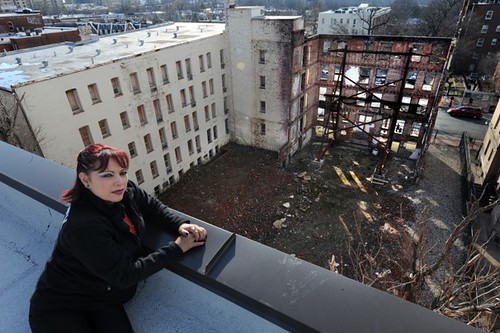No matter what you spout off, re/development takes time

Four years after it was badly burned in a midnight fire, residents of a low-income apartment building on Mount Pleasant Street NW are seeking financial assistance from the District to help rebuild the property, which remains an eyesore in the community. Yasmin Romero-Castillo, Advisory Neighborhood Commissioner for 1D01, sits on a building overlooking what is left of 3145 Mount Pleasant St. NW. Tracy Woodward, Washington Post.
The Post had an article, "Ex-tenants, Mount Pleasant frustrated four years after apartments burned," about one month ago about the frustration in the Mount Pleasant neighborhood over the "inaction" of rehabilitating a building that "burned down" about four years ago, displacing 85 households.
There was a follow up letter to the editor, "Fire swept away the progress," calling this a daily reminder of "the District's lack of action."
Hey, I beat up on "the government" in DC as much as anybody, but the reality is that even in the best of circumstances dealing with something like this can take years.
First, the primary actor responsible for addressing the aftermath is not the DC Government, except through its regulatory powers, it is the property owner. Haggles with the insurance company, getting an architect, coming up with plans, lining up financing all takes time, bidding out the job, selecting contractors and subcontractors, getting building permits, doing construction, etc., takes up a lot of time.
Of course, since the tenants bought the building, they are the ones who now have to come up with the $10 million. And that makes everything that much harder, because tenant-owned properties are harder to finance, and the organization lacks the technical expertise in-house to manage and execute the rebuilding process.
This process takes time, and unless the complainers are ready to step up with multi-million dollar low interest loans, they better develop some patience.
I think about this a lot because, among many examples, of how it will take 12+ years all told to convert the old the Amoco station on the 300 block of H Street NE into a mixed use apartment building with a Giant Supermarket on the site.
(Developing patience is hard, I didn't really start to understand this til I was about 45 years old, and starting to process my various experiences doing revitalization-related work in the H Street neighborhood--the streetscape reconstruction project there was fast-tracked, it'll basically be finished this year, plus one more year for streetcar-related infrastructure. The project started with the planning phase in 2003. That it will be completely done, including a streetcar, in about 12 years is quite good.)
Labels: civic engagement, urban renewal



0 Comments:
Post a Comment
<< Home